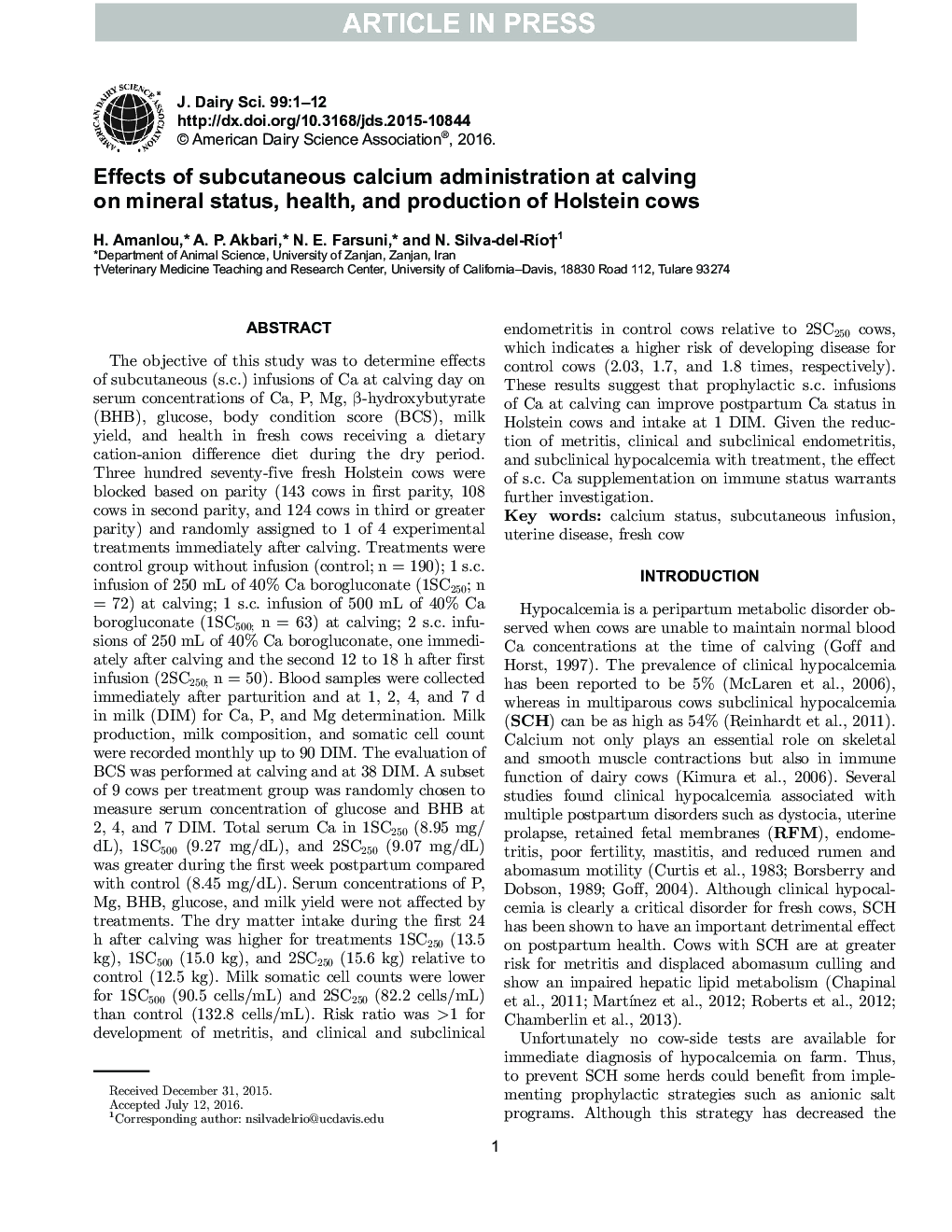| Article ID | Journal | Published Year | Pages | File Type |
|---|---|---|---|---|
| 5542692 | Journal of Dairy Science | 2016 | 12 Pages |
Abstract
The objective of this study was to determine effects of subcutaneous (s.c.) infusions of Ca at calving day on serum concentrations of Ca, P, Mg, β-hydroxybutyrate (BHB), glucose, body condition score (BCS), milk yield, and health in fresh cows receiving a dietary cation-anion difference diet during the dry period. Three hundred seventy-five fresh Holstein cows were blocked based on parity (143 cows in first parity, 108 cows in second parity, and 124 cows in third or greater parity) and randomly assigned to 1 of 4 experimental treatments immediately after calving. Treatments were control group without infusion (control; n = 190); 1 s.c. infusion of 250 mL of 40% Ca borogluconate (1SC250; n = 72) at calving; 1 s.c. infusion of 500 mL of 40% Ca borogluconate (1SC500; n = 63) at calving; 2 s.c. infusions of 250 mL of 40% Ca borogluconate, one immediately after calving and the second 12 to 18 h after first infusion (2SC250; n = 50). Blood samples were collected immediately after parturition and at 1, 2, 4, and 7 d in milk (DIM) for Ca, P, and Mg determination. Milk production, milk composition, and somatic cell count were recorded monthly up to 90 DIM. The evaluation of BCS was performed at calving and at 38 DIM. A subset of 9 cows per treatment group was randomly chosen to measure serum concentration of glucose and BHB at 2, 4, and 7 DIM. Total serum Ca in 1SC250 (8.95 mg/dL), 1SC500 (9.27 mg/dL), and 2SC250 (9.07 mg/dL) was greater during the first week postpartum compared with control (8.45 mg/dL). Serum concentrations of P, Mg, BHB, glucose, and milk yield were not affected by treatments. The dry matter intake during the first 24 h after calving was higher for treatments 1SC250 (13.5 kg), 1SC500 (15.0 kg), and 2SC250 (15.6 kg) relative to control (12.5 kg). Milk somatic cell counts were lower for 1SC500 (90.5 cells/mL) and 2SC250 (82.2 cells/mL) than control (132.8 cells/mL). Risk ratio was >1 for development of metritis, and clinical and subclinical endometritis in control cows relative to 2SC250 cows, which indicates a higher risk of developing disease for control cows (2.03, 1.7, and 1.8 times, respectively). These results suggest that prophylactic s.c. infusions of Ca at calving can improve postpartum Ca status in Holstein cows and intake at 1 DIM. Given the reduction of metritis, clinical and subclinical endometritis, and subclinical hypocalcemia with treatment, the effect of s.c. Ca supplementation on immune status warrants further investigation.
Keywords
Related Topics
Life Sciences
Agricultural and Biological Sciences
Animal Science and Zoology
Authors
H. Amanlou, A.P. Akbari, N.E. Farsuni, N. Silva-del-RÃo,
